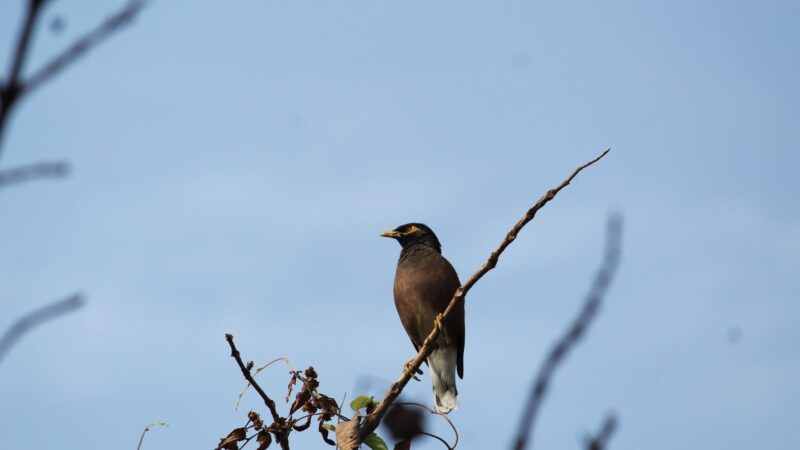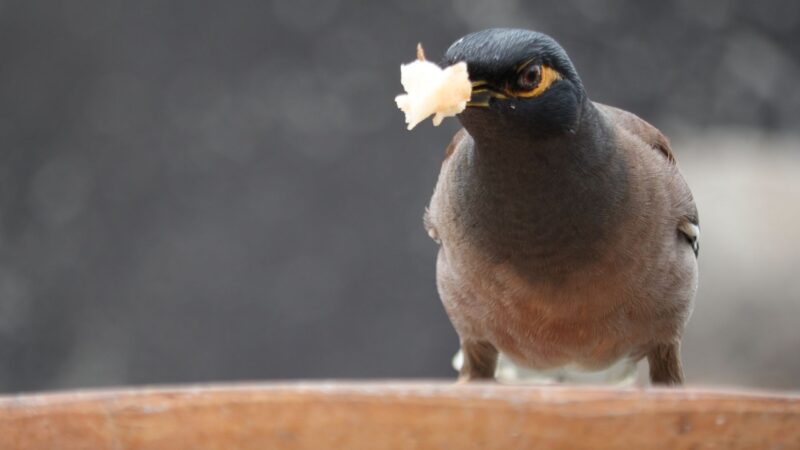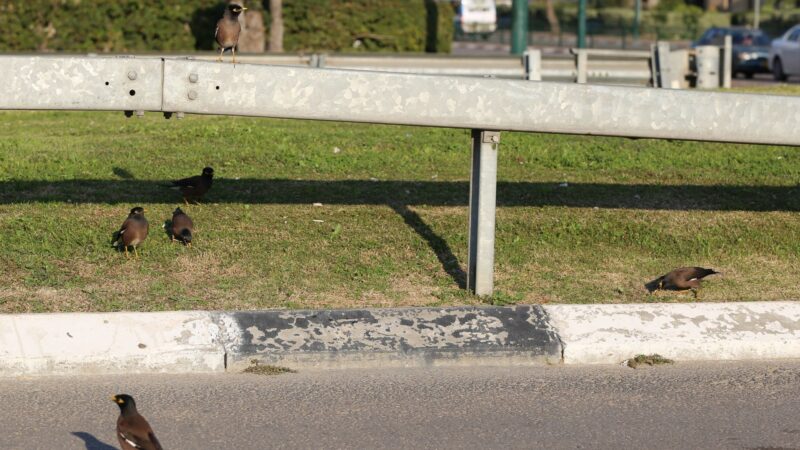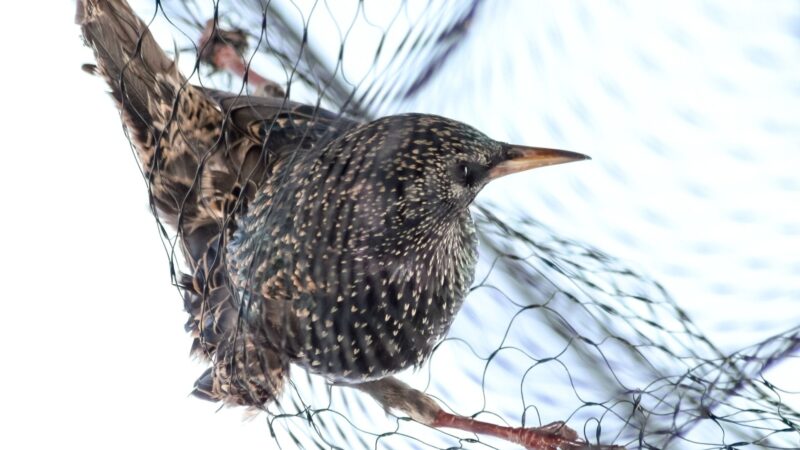Common myna birds are a nuisance not only to humans but also to native wildlife, biodiversity, agriculture, and infrastructure. Not to worry, as this article will provide you with everything you need to know of deterring them.
So, how to get rid of common myna birds? You can do so by using the following non-lethal management strategies: install bird netting, establish bird spikes, put reflective objects in place, use noise deterrents, and apply chemical repellents.
About Common Myna Birds

Common mynas are stocky-bodied, highly adaptable birds that have been widely introduced in many areas around the world. The International Union for the Conservation of Nature considers this species as one of the three sole birds among the world’s Top 100 Most Invasive Species.
- Scientific Name: Acridotheres tristis
- Appearance: Dark brown overall plumage with a shiny black head, upper chest, and neck areas. It also has yellow legs, feet, beak, and eye skin. Its tail tips, undertail coverts, and wing patches are distinctively white.
- Lifespan: 4 years (in the wild); 12 to 25 years (in captivity)
- Habitat: Open agricultural areas, cities, town outskirts, forests, deserts, partially open forests, dry woodlands
- Length: 23 to 26 centimeters
- Weight: 82 to 143 grams
- Wingspan: 120 to 142 millimeters
- Diet: Omnivorous; mainly feeds on grains, fruit, insects, and grubs. But, they also feed on small mammals, snakes, lizards, and the eggs and young of other bird species. They occasionally eat fish.
- Place of Origin: South Asia
- Characteristics: Social birds, often found in loose flocks and roost in large groups. They are sedentary, diurnal, and aggressively territorial.
Are Common Myna Birds Aggressive?
Yes, during the breeding and nesting season. They are known to resort to violent behavior when competing with birds of both the same and other species. They compete over resources, including nesting sites. As a result, local bird populations show a consistent decline.
Related: How to Keep Birds From Nesting on Porch? | The Effective Guide
Why Common Myna Birds Are a Problem?

Common mynas are a bigger problem for more than you think. And here’s why:
Negative Environmental Effects
Myna birds are known to aggressively displace and exclude native wildlife, especially nesting birds and hollow-dependent animals.
In fact, mynas are considered a huge ecological problem in India. A university lecturer pointed out that almost 80% of native bird species have bred less since mynas took over.
Some of the bird species that may be threatened by the presence and increasing populations of common mynas include the regent parrot, glossy black cockatoo, little tern, and flesh-footed shearwater.
Noise Pollution
These birds are also known to flock to residential areas to forage for food and hunt for potential nesting sites. They also socially congregate in large roosts. As such, they produce way too much noise that becomes a nuisance for locals.
Health Hazard
Evidence in Hawaii shows that myna birds are vectors of avian diseases such as malaria. They also harbor exotic parasites which may cause dermatitis, hay fever, and asthma to unsuspecting humans. This includes threadworms and mites.
Damage to Property
Mynas build their nests in urban and suburban dwellings. This includes holes, crevices, and hollows in buildings, bridges, lamp posts, ventilators, and air-conditioning units.
Their fecal droppings may look unsightly and even damage structures. Additionally, they may also invade homes.
Related: How to Prevent Birds Nesting in Roof? | Information and Control Guide
Agricultural Impacts
Common mynas cause moderate damage to orchard fruits such as grapes, strawberries, apples, mangoes, and figs. But, they are also known to bring damage to cereal crops.
Moreover, common mynas are a known major disperser of seeds from pesky and invasive plants such as fireweeds and lantanas.
May Also Hurt Humans
Due to their aggressively territorial behavior, they are also known to attack and injure humans who get into the vicinity of their nests.
One passerby in Dubai reported that a bird dove into her head and dug its claws, causing a major headache the entire day. The myna didn’t stop there as it repeated its attack at least 6 more times.
Related: How to Get Rid of Seagulls | Effective Strategies and Prevention
How to Get Rid of Common Myna Birds?
1. Install Bird Netting
Use wire mesh or nylon netting to protect fruit plants and trees to keep mynas from eating and nesting on them, respectively.
Don’t just drape the netting over the desirable plant. Make sure to also anchor the bird netting to a PVC frame to keep it from falling off. Sod staples, inserted every 2 to 3 feet, may also do the trick.
2. Establish Bird Spikes
For perching sites and elevated surfaces, install bird spikes at a 45° angle to bar them from entering and nesting on these locations.
It doesn’t matter what material it is made up of, as long as the product is specifically designed for smaller birds and offers consistent coverage. This is to make sure myna birds don’t fit themselves between the spikes.
Related: How to Keep Birds Away From Your Car? | Control and Prevention
3. Put Reflective Objects in Place
This includes any objects that can reflect sunlight such as tape, ribbons, old CDs, aluminum foil, and metallic strips. Scatter them around the property, including any type of vegetation, to prevent birds from entering.
4. Use Noise Deterrents
Purchase sound-making devices that produce loud, bird-frightening noises. Consider the following products:
- Ultrasonic sound devices
- ✔️Long Term Use: Different animals, even within the same...
- ✔️2025 New: The animal repellent has increased the working...
- ✔️Solar Fast Charging: We have equipped a solar charging...
- ✔️Waterproof Ultrasonic Animal Deterrent: Solar ultrasonic...
- ✔️Come and use it! : If you are tired of stray animals...
- Bird Preventer: The Bird-X Balcony Gard is an ultrasonic bird...
- Wide Coverage: Our weather-resistant and fully programmable bird...
- Versatile Bird Decoy: With a sound pressure of 90 dB at 1 meter...
- Humane and Reliable: With our ultrasonic bird preventer, you can...
- Easy Operation and Installation: Featuring motion-activated and...
- Sonic Device: The Bird-X Critter Blaster PRO is a sonic device...
- Forces Away Birds and Animals: Our critter-preventer device...
- Humane Ultrasonic Machine: Instead of chemicals or traps, this...
- Extensive Coverage: Using loud recordings, this weatherproof...
- Easy Installation: This decoy device contains a weather-resistant...
- Bird alarm or distress call devices
- Scare Starlings with predator calls
- Frighten away crows with recorded bird distress sounds
- Warning/Advice- All audio & visual bird deterrents are not stand...
- Scare Away Problem crows
- Recorded sounds of starling predators & birds in distress
- The original Audubon bird call. Recognized by multiple...
- The bird call's sound is produced by rotating the wooden cylinder...
- Originally conceived by songbird hunters in Europe, the bird call...
- Be sure to keep the instrument dry; a small amount of the...
- Total length approximately 2.5" x 0.75" wide.
- This call reproduces the sound of a bird in distress, chased by a...
- The small predators, attracted by the hope of easy spoils will be...
- Can also be used as a decoy for woodcock
- Comes with a DVD and a technical manual
5. Apply Chemical Repellents
These products contain non-toxic substances that, when applied to perching or nesting surfaces, will become sticky or slippery to the birds. And, as a result, this effectively gets rid of them and even prevents them from coming back.
One of the most sought-after chemical repellents is Avian Control which contains a bird irritant called methyl anthranilate.
How to Manage Myna Birds Infestation?

When addressing myna bird yard infestations, a meticulous approach should be used. Here are some of the things you can do:
- As much as possible, eliminate any sources of food and water. Secure trash bins and dispose of any spills and wastes.
- Close off any potential nesting sites, which includes holes and hollows in structures. Seal, caulk, or apply a screen when necessary.
- Help increase ecosystem biodiversity by planting vegetation that is attractive to native bird species.
- Consult with a professional wildlife expert if the solutions mentioned earlier are unsuccessful at getting rid of common mynas.
- Be on the lookout for signs of mynas around the area. Once spotted for any telltale signs (e.g., fecal droppings, nesting material), address the problem immediately.
Related: How to Get Rid of Chimney Swifts? | Proven Strategies and Solutions
How to Trap Myna Birds? | Step by Step Guide

Generally, bird trapping and relocation is only recommended for localized infestations as they are ineffective for severe ones.
If you insist on trapping myna birds, simply follow these steps:
- Purchase or construct a walk-in cage trap: These products come in a variety of capture mechanisms (e.g. funnel door, drop-in gate). Choose which works best for you.
- Place the trap under trees or near vegetation: This is because these are usually the places myna birds would frequently go to.
- Consider pre-baiting the trap 2 to 3 weeks before: This lets the birds become used to the trap. Use fruits, insects, vegetables, or grains as bait. Replace the bait if it rots.
- Follow the label or instructions to the trap and set it up: Make sure that everything is secure. The trap should be placed on a level site with no gaps. In the case of gaps, cover it with soil if necessary.
- Monitor the trap: Look out for predators that may be attracted to the bait. Regularly check it to see if any birds have been caught inside and promptly release local bird species.
- Perform relocation efforts: Once myna birds have been captured inside the trap, relocate them to a far away area. Abide by local rules when it comes to relocating birds. Consult with a professional wildlife expert if necessary.
- Regularly sanitize and maintain the trap: This involves cleaning up any fallen debris and dirt as well as replenishing the bait when necessary.
It is important to note that trapping is time-consuming, labor-intensive, and costly. These are exactly the reasons why it isn’t used as a primary strategy in getting rid of myna birds.
Consider non-lethal techniques first and consult with professional wildlife experts before deciding to set up traps.
Related: How to Get Rid of Northern Mockingbird? | 7 Simple Ways
List of Sources
Avery, M.L. & Eisemann, J.D. (2014). Invasive Myna Control in American Samoa.
Brittingham, M. C., & Falker, S. T. (2005). Controlling Birds Around Farm Buildings.
Council of the City of Gold Coast. (n.d.). Common myna.
Davidson, M. (2018). Myna: An Offensive Bird.
Godfrey, L., & Hurley, J. (n.d.). IPM Action Plan for Nuisance Birds.
Government of New South Wales. (n.d.). Myna birds.
Hurley, J. A. (2020). Birds, Bees and Bats: What do you do when you encounter them
- How to Get Rid of Copperheads | Practical Guide - August 27, 2023
- How to Get Rid of Corn Snakes | What Makes Them Aggressive? - August 27, 2023
- How to Get Rid of Alligators | Safety Measures and Removal Methods - July 16, 2023






